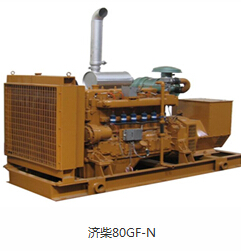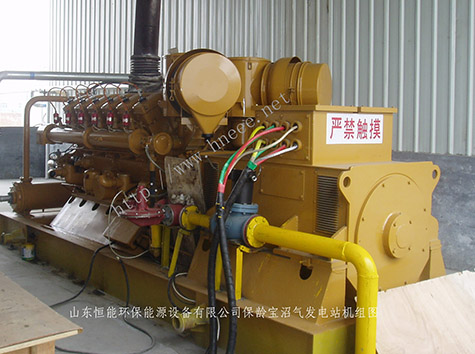沼气发电机组是如何进行沼气的制取的?
1.严格的厌氧环境沼气发酵微生物包括产酸菌和产甲烷菌两大类,它们都是厌氧细菌,尤其是产生甲烷的甲烷菌对氧特别敏感。它们不能在有氧的环境中生存,哪怕微量的氧存在,也会使发酵受阻。因此,建造一个不漏气、不漏水的密闭沼气池,是人工制取沼气的关键。

1. Strictly anaerobic environment, biogas fermentation microorganisms include acidogenic bacteria and methanogens. They are anaerobic bacteria, especially methane producing bacteria, which are particularly sensitive to oxygen. They cannot survive in an aerobic environment. Even a small amount of oxygen will hinder the fermentation. Therefore, the construction of an airtight and watertight biogas digester is the key to the manual production of biogas.
2.足够和优良的接种物接种物是沼气发酵所需要的含有大量微生物的厌氧活性污泥,也称菌种。只有具备足够优良的接种物才能保证沼气发酵高能运行。农村户用沼气池的接种物一般来源于老沼气池的沼渣(沼液)、阴沟的污泥、粪坑底部的沉渣等。接种物用量一般占总发酵液的30%左右。
2. Sufficient and excellent inoculum inoculum is anaerobic activated sludge containing a large number of microorganisms required for biogas fermentation, also known as bacteria. Only with enough excellent inoculum can we ensure the high-energy operation of biogas fermentation. The inoculum of rural household biogas digester generally comes from the biogas residue (biogas slurry) of the old biogas digester, the sludge of the sewer, the sediment at the bottom of the cesspit, etc. The amount of inoculum generally accounts for about 30% of the total fermentation broth.

3.必要的发酵温度沼气发酵菌种在8℃~60℃范围内都能发酵产气,并且温度越高,发酵越活跃,产沼气越多。因此,作为常温发酵的农村户用沼气池,应尽量使其发酵温度保持在8℃以上。
3. Necessary fermentation temperature biogas fermentation strains can produce gas in the range of 8 ℃ ~ 60 ℃, and the higher the temperature, the more active the fermentation and the more biogas. Therefore, as a rural household biogas digester fermented at room temperature, the fermentation temperature should be kept above 8 ℃ as far as possible.
4.适宜的酸碱度在沼气发酵过程中,沼气菌适宜在中性或微碱性的环境中繁殖。发酵液的ph值控制在6.8~7.5为宜。如低于或高于此值,沼气发酵就会缓慢,甚至不能正常进行。
4. Suitable pH during biogas fermentation, biogas bacteria are suitable to reproduce in neutral or slightly alkaline environment. The pH value of fermentation broth should be controlled at 6.8 ~ 7.5. If it is lower or higher than this value, biogas fermentation will be slow and even can not be carried out normally.
5.适宜的发酵浓度和碳氢比作物秸秆、青草、人畜粪便、生活污水等有机物都可以作为沼气发酵的原料。但发酵原料需满足(20~30):1的碳氮比和满足6%~10%的发酵浓度。当然,碳氮比和发酵浓度在夏季可适当低些,在冬季可适当高些。
5. Suitable fermentation concentration and hydrocarbon ratio, crop straw, grass, human and animal manure, domestic sewage and other organic matter can be used as raw materials for biogas fermentation. However, the fermentation raw materials should meet the carbon nitrogen ratio of (20 ~ 30): 1 and the fermentation concentration of 6% ~ 10%. Of course, the carbon nitrogen ratio and fermentation concentration can be appropriately lower in summer and higher in winter.
6.经常性的搅拌沼气池。在不搅拌的情况下,发酵料液明显地分为3层:上层结壳层、中层清液层、下层沉渣层。发酵液分层不利于产气,所以,应考虑采取搅拌措施。搅拌的目的是使其不分层,让原料和接种物均匀分布于池内,增加微生物与原料的接触面,加快发酵速度,提高产气量。此外,搅拌也有利于沼气的释放。对有加热装置的沼气池来讲,搅拌有利于热能的传播。目前,采用的搅拌方法主要有3种:机械搅拌、液搅拌、气搅拌。
6. Regularly stir the biogas digester. Without stirring, the fermentation broth was obviously divided into three layers: upper crust layer, middle clear layer and lower sediment layer. Stratification of fermentation broth is not conducive to gas production, so stirring measures should be considered. The purpose of stirring is to make it non layered, evenly distribute raw materials and inoculum in the tank, increase the contact surface between microorganisms and raw materials, accelerate the fermentation speed and improve gas production. In addition, stirring is also conducive to the release of biogas. For biogas digesters with heating devices, stirring is conducive to the transmission of heat energy. At present, there are three main mixing methods: mechanical mixing, liquid mixing and gas mixing.
7.严防加入抑 制 剂。抑 制 剂主要是一些重金属离子、农药及一些有毒性物质。这类物质不能加入沼气池。
7. Strictly prevent the addition of inhibitors. Inhibitors are mainly some heavy metal ions, pesticides and some toxic substances. Such substances cannot be added to the biogas digester.
 在线咨询
在线咨询 官方二维码
官方二维码




 当前位置:
当前位置: 2021.08.05
2021.08.05






